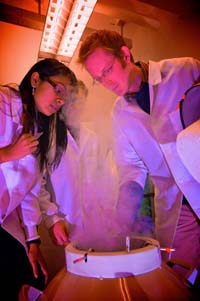New Study Reveals Ozone’s Hidden Toll on America’s Trees
A new nationwide study reveals that ozone pollution—an invisible threat in the air—may be quietly reducing the survival chances of many tree species across the United States. The research, published in the Journal of Geophysical Research: Atmospheres is the first…


 Most cell biomechanics research has examined cell behavior on unchanging, flat surfaces. “Living cells are remarkably complex, dynamic and versatile systems, but the material substrates currently used to culture them are not,” says Henderson (at right in photo). “What motivated our work was the need for cell culture technologies that would allow dynamic control of cell-material interactions. We wanted to give a powerful new tool to biologists and bioengineers.”
Most cell biomechanics research has examined cell behavior on unchanging, flat surfaces. “Living cells are remarkably complex, dynamic and versatile systems, but the material substrates currently used to culture them are not,” says Henderson (at right in photo). “What motivated our work was the need for cell culture technologies that would allow dynamic control of cell-material interactions. We wanted to give a powerful new tool to biologists and bioengineers.”